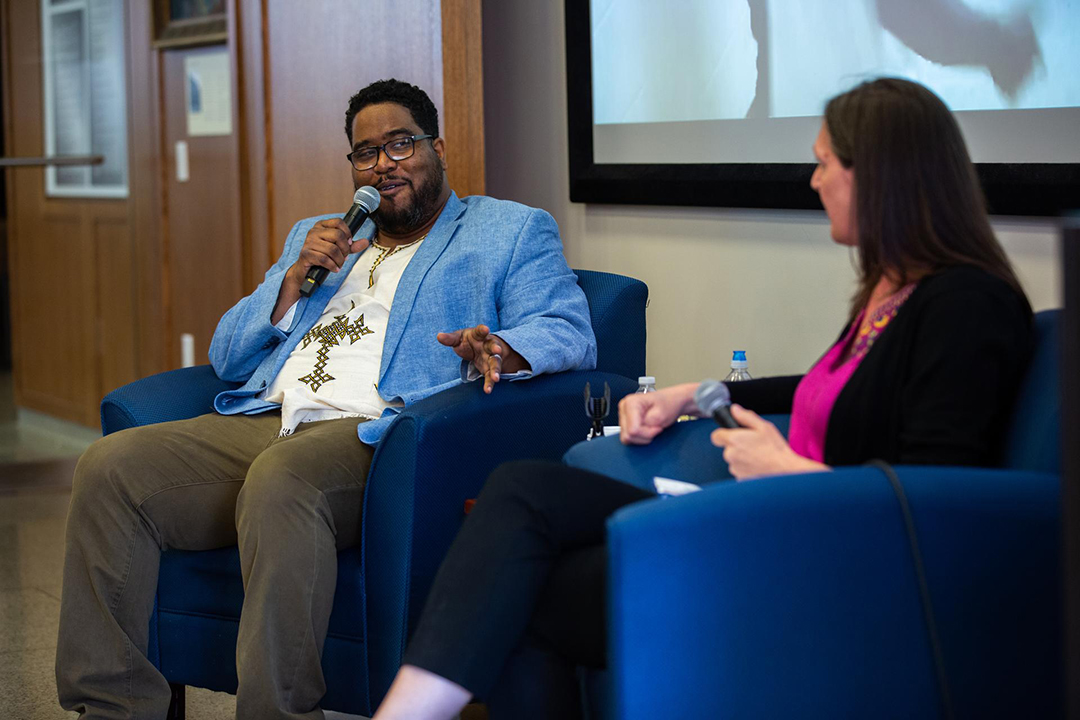By Ruth Steinhardt
Outside of Washington, D.C., Gabriel “Asheru” Benn is perhaps best known as the first rapper to win a Peabody Award, in 2006, for his work on the animated show “The Boondocks.” But in his native city, Mr. Benn is known as a provider of resources for kids who have few others. Through his arts organization, Guerilla Arts Ink, he runs youth and community programs that connect students with local artists, teaching them creative skills and also helping build the spaces in which their art can flourish.
Speaking Wednesday night at the George Washington University, Mr. Benn said his parallel careers as artist and educator were inextricable from each other. In fact, he said, having a creative passion can be crucial to effective communication with students.
“I tell teachers all the time: Take your passion, your side hobby, and bring it into the classroom,” he said.
Mr. Benn came to the George Washington University Museum and The Textile Museum as part of the Graduate School of Education and Human Development’s “Conversations that Matter” series. He joined Maia Sheppard, assistant professor of curriculum and pedagogy at GSEHD, for a conversation structured around the museum’s “Enduring Ideals: Rockwell, Roosevelt & the Four Freedoms” exhibit.
“I started as a classroom teacher, a core subject teacher,” Mr. Benn said. “It wasn’t until year three or four that I started to realize I needed other ways to teach this old, boring stuff.”
One of Guerilla Arts’ first programs was the Hip Hop Educational Literacy Program, which used music as a tool to teach basic literacy skills.
“Growing up through hip-hop culture, hip-hop was my go-to,” Mr. Benn said. “The arts have always allowed me to do things that core subjects alone wouldn’t let me do.”
But the importance of art in education isn’t just that it can spice up a drab lesson in another subject, Mr. Benn said. For young students, art has a grander purpose as a source of community and direction in itself.
“It’s not just what they learn from it, it’s how they demonstrate what they’ve learned,” he said.
Before Mr. Benn shifted his focus to afterschool and summer programs, he worked at a small special education institution that graduated only about eight or nine students a year. Few continued their education.
“Even the guidance counselor said ‘You know these kids aren’t going to college—why even try?’” Mr. Benn remembered.
Mr. Benn wasn’t ready to give up. “My directive was, we need to bring more artists into the school and have the students looking at art as a vocational pathway,” he said.
He brought in a full court press of local artists. Members of his band came in to assist the music teacher. An artist who did flyers for Asheru’s shows came in to teach graphic design. A stylist came in to discuss fashion and merchandising. Emcees led English lessons.
“I just tried to bombard the school with all these different outlets and options,” he said. “After about two years of doing this, we graduated our largest graduating class of 14 students. Of the 14, nine went on to college or culinary or studio engineering schools. They found their way out.”
Mr. Benn’s philosophy is that art can also be incorporated across the curriculum and in unexpected ways. In one classroom, Mr. Benn had a full turntable set up so he could play and discuss music with them—“Everything from Parliament to Haydn.” He convinced one principal to play beats instead of bells to signal the time between classes. Students began to clamor to be allowed to “score” the day’s classes, some even making their own tracks. (“There were some we couldn’t play,” Mr. Benn admitted.)
“Art provides a voice for the voiceless, it provides access to folks that otherwise wouldn’t have access,” he said.
Mr. Benn was more interested in the third floor of “Enduring Ideals,” where contemporary artists responded to Norman Rockwell’s work, than in the four central paintings themselves.
“You have to put it in the context of now,” he said. “I work in populations characterized as underserved, underrepresented, high violence, high poverty, high crime. So when you say ‘freedom from fear’—a lot of our kids, and a lot of our adults, are living in fear.”
In his own neighborhood, Mr. Benn said, he sometimes fears a bullet coming through his window.
“Freedom from fear—who’s represented in that?” he asked. “Who’s free from fear? And can you really learn when you’re in a fear pose? How can you learn anything? I’m not just talking about underserved, underprivileged communities. School shootings happen in affluent neighborhoods. Every day, day to day, you never know what can happen. I don’t know if, politically, we’re living in a time when we can be free from fear.”


